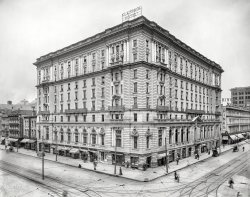
MAY CONTAIN NUTS

Search Shorpy
SHORPY ART

Framed or unframed, desk size to sofa size, printed by us in Arizona and Alabama since 2007. Explore now.
Join and Share
Ad-Free Shorpy
Shorpy is funded by you. Patreon contributors get an ad-free experience.
Learn more.

Recent comments
- There is an interesting novel set here.
- I Was In Berlin
- Pronunciation
- Shell of a Shell
- Never been there but
- BUR-lin
- Hand-made smokes
- Birthplace of Tupperware, or at least its inventor
- Pulp
- Remarkably unchanged in 84 years
- The church is still there ...
- Talk about a smoke show
- Electric Hansom Cab
- I wondered the same thing.
- The location in 2009
- Pill Pusher
- Roll your own
- Rugged and real!
- Civil War history
- Early EV?
- A Charles Purcell - Mama Cass Connection
- Uncle SAAM
- Obfuscation
- One Chocolate Soldier rode away
- Victor Marquis de la Roche
- The Little House Across Way ...
- Vanderbilt Gates
- Vanderbilt Mansion
- You can still see that gate
- Withering heights for me
Member Photos
The Shorpy
Printporium
Printporium
Search Shorpy
Search results -- 30 results per page
- Hotel DeSoto: 1908
- Circa 1908. "DeSoto Hotel, Savannah, Georgia." Automobilists welcome! 8x10 inch dry plate glass ... are welcome too!
Gone With the Wind The Desoto Hotel opened in 1890. It was designed by William Gibbons Preston, a Boston ... remarkable Romanesque buildings in Savannah.
The Desoto Hotel was revered as one of Preston's masterpieces. The hotel was torn down in ... Posted by Dave - 06/14/2014 - 8:49am -
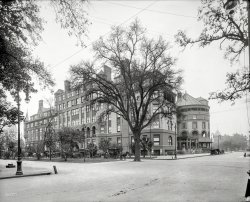
- Hotel McAlpin: 1912
- New York circa 1912. "Hotel McAlpin, Herald Square." 1,500 rooms with, the sign informs, ... View full size.
Communicating Baths The hotel I grew up in was built around the turn of the 20th century. Though not as ... though. It seems to persist abroad, if international hotel advertisements online are any communication - I mean, indication.
A ... Posted by Dave - 08/01/2012 - 5:45pm -
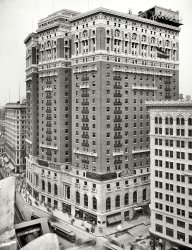
- The New Hotel: 1908
- ... ROCHESTER, Sept. 13 — Rochester’s new hotel, the Seneca, will be opened tomorrow in time for the State Democratic ... here Tuesday. The hostelry in size will compare with the Hotel Astor in New York. Its architecture is in a general way French ... Posted by Dave - 02/17/2017 - 6:25pm -
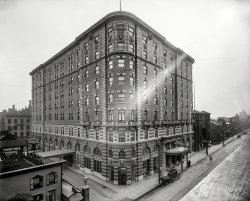
- 66 & 85: 1943
- ... A nice article on the former Hilton, now the Andaluz Hotel, the ten-story building in the background:
https://hauntedhouses.com/new-mexico/hotel-andaluz/
Before/After Most of these "here's what it looks like ... Posted by Dave - 07/29/2024 - 9:59pm -
![66 & 85: 1943 February 1943. "Albuquerque, New Mexico. Stores on West Central Avenue." An alternate view of this corner. Acetate negative by John Collier for the Office of War Information. View full size.
In just nine years ...Maybe the buildings haven't changed all that much, but maybe the world has gotten a bit more suspect ... or suspicious.
[Or thirsty. The fence is from a sidewalk cafe. - Dave]
+72Below is the same view from July of 2015.
Ye olde moderneMontgomery Ward, front and center in this photo, was one of a number of retailers that attempted to develop a look, erecting these pseudo-colonial boxes in small-to-mid-sized cities across the country. While hardly at the level of S.H. Kress' art deco masterpieces, they nonetheless got the job done, even today being readily recognizable (at least when they haven't been covered over).
A different kind of shoppingThe Woolworth and Montgomery Ward buildings are still there, but of course the retailers are long gone. Whomever Whoever remodeled the facade of the Ward's building, to make it look more Southwestern, didn't do it any favors. The interesting brick buildings to the right of that, to the corner, are gone. Street View shows the businesses located there now include a gentlemen's club and a tattoo parlor.
Yes, Dave, you caught me. But you also reminded me of a joke that was a favorite of an English professor at UT Austin.
Knock-knock.
Who's there?
F@#k.
F@#k who?
F@#k Whom.
Haunted HiltonA nice article on the former Hilton, now the Andaluz Hotel, the ten-story building in the background:
https://hauntedhouses.com/new-mexico/hotel-andaluz/
Before/AfterMost of these "here's what it looks like now" photos seem so sterile. Sure, it may be cleaner, but there are so few people to be seen. No hustle and definitely no bustle.
(The Gallery, Albuquerque, John Collier, Stores & Markets, WW2)](https://www.shorpy.com/files/images/SHORPY-8d14823u.thumbnail.jpg)
- Plaza Hotel: 1912
- New York circa 1912. "Plaza Hotel, Fifth Avenue at 59th Street." The original "big box." 5x7 glass ... View full size.
High End Digs The Plaza Hotel, built in 1907, is now a condominium as well. There are listings for 3 ... on a pig?"
Eloise Any mention of the Plaza Hotel to a native New Yorker immediately conjurs up remembrances of it's most ... Posted by Dave - 03/04/2013 - 10:09am -
![Plaza Hotel: 1912 New York circa 1912. "Plaza Hotel, Fifth Avenue at 59th Street." The original "big box." 5x7 glass negative, Detroit Publishing Company. View full size.
High End DigsThe Plaza Hotel, built in 1907, is now a condominium as well. There are listings for 3 bedroom apartments, 2 are available, one at $11,995,000 and the other $14,750,000. If a 3 bedroom won't work for you there are 2 4BR units offered for $25,000,000 and $55,000,000, respectively The prices are negotiable and pets are allowed.
Big Box IndeedRemarkably large and unattractive. Wonder if the filigree on top prompted the first usage of "lipstick on a pig?"
EloiseAny mention of the Plaza Hotel to a native New Yorker immediately conjurs up remembrances of it's most famous "guest" Eloise, even though she never actually stayed there.
Before the hotel became condos, they held an auction at which almost every item from the original hotel (from furniture to doorknobs) were sold at unbelievable prices. Eloise kind of disappeared during the renovations, but just made her grand re-entrance.
Welcome Home, Eloise !
Unattractive?I think it shows a magnificence that no longer is ever built.
What is it about Shorpy photos?The sheer size, massiveness and height of this amazing building is eye-popping. What IS it about so many DPC photos, which seem much more grand, especially compared to the street maps we compare with today? Those DPC photogs had an amazing eye for their work.
Yes, it's just a big block-long-and-wide square, but the architects at least topped it off in an interesting way, giving it an incredible grandeur.
I'd pay a tidy sum for a chance to put up the flags up there any morning, or to look out over NYC from one of those turrets.
Well, the awnings have gone -- and there are fewer horses.
View Larger Map
Sic TransitAnd now it's partly condos, and not an awning to be seen ... better than ending up like Penn Station, however.
Glorious BuildingHere's to another 100 years, plus! What changes will it see by then.
Main EntranceThese days the main entrance is on the Fifth Avenue side, through the porch with the six white columns. There is still a door facing Central Park South, where the big marquee is in this pic, but I don't think it even has a taxi rank anymore. I guess it keeps the traffic flowing better.
John, Paul, George, and RingoThe Beatles camped out at the Plaza during their first collective visit to America in February 1964. George was laid up in the room with a bad cold on Feb. 8, whilst the other lads went larking about Central Park. By the evening of Sunday the 9th, George recuperated well enough to take the stage with the others on the Ed Sullivan Show. The rest you already know.
Stepping out?Looks like someone is stepping out backwards. Left corner turret, top floor. Hope I'm wrong.
[Looks like you're right. Eek. - tterrace]
Pre "Health and Safety"Well spotted ProMagnon, but I'm fairly sure he's cleaning the window. His belt might be fixed to an anchor point inside, but somehow I doubt it.
(The Gallery, DPC, NYC)](https://www.shorpy.com/files/images/SHORPY_4a27612a1.thumbnail.jpg)
- Rust Belt Riviera: 1912
- ... it's difficult because I can't pick out the Renaissance Hotel, where all of the baseball players stay, and which would have been a ... Posted by Dave - 07/21/2024 - 2:02pm -
![Rust Belt Riviera: 1912 Pittsburgh, Pennsylvania, circa 1912. "A group of skyscrapers." Behind the sapling, the Wabash Bridge over the Monongahela River; in the distance, the Sixth Street Bridge over the Allegheny. 8x10 inch dry plate glass negative, Detroit Publishing Company. View full size.
Three track mindHow many passenger stations can you spot? I see three: Pennsylvania/Union, Federal Street and the Wabash (the destination for the bridge in the foreground). The photo, I think, is a little later than 1912, since Kaufmann's Annex -- opened in late 1913 -- is completed, but it's still bright and clean looking (and how long would that last in Steel City's smoky skies?), so probably not too long after that; and before 1915, since Rosenbaum's isn't in evidence.
Reach for the sky, 1912 styleImmigrants and visitors must have been impressed about all those skyscrapers.
Incline to the rightI'm pretty much drawn to the incline in the upper right that looks like it comes from the Strip District into the Hill District or thereabouts.
Only two survive in Pittsburgh now and that is not one of them.
[It's the Penn (17th Street) Incline over Bigelow Boulevard, dismantled in 1956. - Dave]
I grew up in Brookline. The site with that link to the picture is a great site for all things Pittsburgh and a lot of great pictures.
Taken from the P.J. McArdle Roadway?The fence and general position look about right.
Six years oldWe love Pittsburgh. The lovely yellow bridges! The Duquesne and Monongahela Inclines! PNC Park! Our last visit was in May, to see our Cubs play the Pirates. It was a dramatic weather day with typical blustery Pittsburgh skies (rain delay at the ball park later), and I took a walk across the Sixth Street (Roberto Clemente) Bridge and met a meandering goose and took pictures of everything on both sides. I'm trying so hard to get oriented in this picture but it's difficult because I can't pick out the Renaissance Hotel, where all of the baseball players stay, and which would have been a youngster in this photo.
Keenan BuildingAt the center of the photo is my favorite building in Pittsburgh, the Keenan Building. The old postcard shows the dome covered with its original gold-colored tiles and topped with a large globe and eagle. The dome is now painted red and the globe and eagle are long gone.
I worked across the street on the 23rd floor of the former FreeMarkets Building, and had a nice view of the Keenan.
In 1912Pittsburgh wasn't the Rust Belt, it was the heart of steel production for a growing country.
Another angleThe view across the Monongahela River to the Henry W. Oliver building at 535 Smithfield St. is still unobstructed. And, along the riverfront, a block of small buildings from c1912 are extant.
click to embiggen
(The Gallery, Boats & Bridges, DPC, Pittsburgh)](https://www.shorpy.com/files/images/SHORPY-4a25725a.thumbnail.jpg)
- Hotel Gayoso: 1910
- Memphis, Tennessee, circa 1910. "Hotel Gayoso." 8x10 inch dry plate glass negative, Detroit Publishing Company. ... cubes of glass set in the sidewalk (seen in front of Hotel Gayoso) were to let light down to the basements beneath the streets.
... gasworks, bakeries, wine cellar, and sewer system, the hotel offered amenities far beyond those available to the rest of Memphis. The ... Posted by Dave - 08/14/2012 - 11:38am -
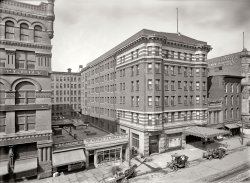
- Grand Hotel: 1904
- New York circa 1904. "Hotel Manhattan, Madison Avenue and 42nd Street." 8x10 inch dry plate glass ... People come, People go, Nothing ever happens The Grand Hotel in Berlin 1932 had Greta Garbo, John Barrymore, Lionel Barrymore, Joan ... - tterrace]
From beautiful to bland The Manhattan Hotel was constructed in 1897, designed by architect Henry J. Hardenbergh. ... Posted by Dave - 04/20/2014 - 12:24am -
![Grand Hotel: 1904 New York circa 1904. "Hotel Manhattan, Madison Avenue and 42nd Street." 8x10 inch dry plate glass negative, Detroit Publishing Company. View full size.
People come, People go, Nothing ever happensThe Grand Hotel in Berlin 1932 had Greta Garbo, John Barrymore, Lionel Barrymore, Joan Crawford, Lewis Stone, Wallace Beery, and many other talented folks.
I'm sure New York had their share of famous folks too.
Trolley CarI assume the car got its power from what looks like a third rail between the tracks. Wasn't that kind of dangerous, seeing how it's street level for anyone to step on?
[New York had many cable car lines at the time. And trolleys using street-level electrical power accessed the underground line through a slot in the pavement, not via a third rail. - tterrace]
From beautiful to blandThe Manhattan Hotel was constructed in 1897, designed by architect Henry J. Hardenbergh. Hardenbergh was also the architect for the Carnegie Hall tower additions (1894), the Dakota Apartments (1881-84), the former Waldorf Astoria Hotel (1893 – currently the site of the Empire State Building) and the Plaza Hotel (1909).
The Manhattan Hotel was demolished in the 1960s for the current Sperry & Hutchinson Building (aka 330 Madison). The new building, a forgettable glass and steel tower, was constructed in 1964. Designed by Kahn & Jacobs Architects, it is 41 stories (555 feet) tall.
I'll have to ask grannyThe front of the hotel was on seedy 42nd street, and the side on Madison Avenue from 42nd to 43rd. The photo looks as if it were taken from a building obstructing Madison Avenue. The streetcar tracks curve out of the way, too.
(The Gallery, DPC, NYC, Streetcars)](https://www.shorpy.com/files/images/SHORPY_4a17565a.thumbnail.jpg)
- Radio City: 1932
- ... most would find it a handsome building.
Park Central Hotel Radio City Music Hall fronts 6th Avenue, between W 50th and W 51st ... the 1932 photo is the five-year-old, 25-story Park Central Hotel. It was and is located at 870 7th Ave , between W 55th and W 56th ... Posted by Dave - 11/02/2023 - 11:39am -
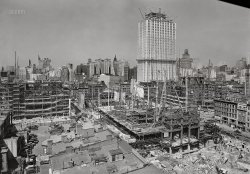
- Bathing in the Casino: 1889
- ... "Bathing pool in the Casino. (Probably the Ponce de Leon Hotel, St. Augustine, Florida.)" UPDATE: This was actually the nearby Hotel Alcazar (thanks to Amphalon). Photograph by William Henry Jackson. View ... Posted by Dave - 07/26/2012 - 4:53pm -
![Bathing in the Casino: 1889 Circa 1889. "Bathing pool in the Casino. (Probably the Ponce de Leon Hotel, St. Augustine, Florida.)" UPDATE: This was actually the nearby Hotel Alcazar (thanks to Amphalon). Photograph by William Henry Jackson. View full size.
Miss Teschmacher!I second the Lex Luthor assessment. A fantastic pool. More hotel pools need to be like this!
BermudaIs that the flag of Bermuda on the rafter? I'd LOVE to swim in this room today ... that's just an incredible pool!
AquabaticistsIs there such a word to describe that team of athletes in the pool? It just came to me, a silly word that some Victorian sideshow pitchman would come up with to describe them.
Is this pool still around? Bears an eerie resemblance to Lex Luthor's swimming pool in the movie Superman.
MGMWow! This would make a great set for one of those MGM Musicals of the late 40s or early 50s! Dynamite!
Hotel Alcazar CasinoAlong with the Ponce de Leon, the Alcazar was one of Henry Flagler's grand hotels. Today it houses St. Augustine City Hall and the Lightner Museum. The pool is now the Cafe Alcazar:
International House of SplashingThe architecture is quite innovative for its day, and combines the usual eclectic mix of details: inspired by a classical Roman bath, the cast concrete structure combines Roman arches and corner vaults with Greek Doric columns, Venetian Renaissance balustrades, and Spanish corbels and roof trusses. Add to these the electric chandeliers (early enough to have been installed by Edison), the Japanese paper lanterns, and the flags of many nations. The paper lanterns over the shower stalls are in the shape of Japanese carp, a pretty amusing touch in this context.
My first thoughtafter viewing all these wonderful photos from this period something is missing. They didn't have fashionable headwear for the swimmer.
Pointed QuestionThere's something here that no one's commented on yet. A topic of seemingly endless discussion in other posts. What could it be?
Going UnderI'm not sure I could bring myself to get in this pool on a dare. Underwater nooks and crannies terrify me. I have nightmares that look just like this, except the pool's at least three (flooded) stories deep. *shudder*
REPLY TO POINTED QUESTIONHeavens, there are no handrails or guard rails anywhere!! Someone might fall in. People should be protected against harming themselves.
Swing babyWell, I don't know if this is what your are alluding to, but are those swing type apparatus on the left for hanging onto and doing???
Boys night outWhere are the women swimmers?
Drowned cityGoing Under's comment on the spooky quality of this pool is well made, especially given the "today" photo of the Cafe Alcazar. As the polar caps continue to recede, the dining room might regain its historical appearance in time for its bicentennial.
A shocking detailSomehow the idea of having electric lighting fixtures dangling directly above the swimming pool gives me the willies.
In the swing of thingsOn the left side of the photo, notice the ropes with handholds hanging from the ceiling. I'm guessing that these were used by people wanting to swing from the balcony and drop into the pool, sort of like an old fashioned tire swing.
Since the water only appears to be a few feet deep, I don't thing I'd be first in line to try this stunt!
Without the caption...Agree with "Going Under." If the caption hadn't said it was a pool, I would have thought it was a flooded opera house or theater, with young folks taking advantage of the disaster as they often will.
The architecture is all wrong for a pool; it's much easier to get trapped under a balcony than to climb out onto a tiled floor.
No bathtub rings, please!Here's a nice touch: Note the showers (with hot and cold faucets) in little alcoves at the top of the stairs leading to the pool.
No handrails on the stairs, though, even though everyone using them had wet, slippery feet!
Top Man's CrotchThat's not the name of a town in the Rockies. It's my answer to the Pointed Question.
Hmmm . . . let's see I'm wondering if this pool is filled with sea water. I would assume it's not chlorinated. There are showers in the corners for rinsing off. The niches now have potted plants.
But what topic could you be referring to, Dave?
Let's see. There are only men in the pool. I suppose in those days there were no ladies' hours at all. They all have fine mustaches. It's cute to see the ladies demurely watching them. Maybe it's the baggy wool swimsuits? But they don't seem to be . . . er . . . revealing anything inappropriate. Maybe I need to enlarge the picture?
Oh yesAnd those trapezes look like they'd be lots of fun to swing from and fly into the water.
Casinos, then and nowGiven that our modern understanding of the term "Casino" that is almost exclusively synonymous with "Gambling Hall" I was surprised that I didn't see any comments about how hard it would be to put all your money on Black (that's a Roulette joke).
Of course the 19th century mind would have understood "Casino" as meaning "a public building where pleasurable activities, including gambling, and sports took place."
Pointed, pointed.....nope, not getting the hint. A little vexillology, perhaps? Alas, not the flag of Bermuda. The two identifiable flags I could make out are the Canadian Red Ensign and the Irish Flag of Leinster. The Canadian Red Ensign is the UK colonal flag with the Canadian crest (crest, crown, and a maple leaf wreath), though it was technically "unofficial", because they kept changing the crest every time a province was added and not standardized until the 1920s. The Irish flag to its left served as the "unoffical flag of Ireland" until 1922.
[You are so very close to the forest. With various inconsequential trees getting in the way. A "pointed" question. What could that mean? - Dave]
Virtual TourNice 360 degree panorama of the current space here.
Must have been dangerousI wonder how many folks were seriously hurt climbing the stairs there to get to those showers. Without guardrails of any sort to hold onto.... one slip on the slippery steps and CONK! Busted skull.....
Dave, since there aren't any nubile ladies in swim atire in the picture (all of the females are barely seen, and fully clothed in circa 1889 high fashion), I don't see what you're pointing to about the thing everyone's missed... unless it's "How the heck would you safely change a lightbulb from that chandelier while it's over the pool without getting electrocuted?" Or are you referring to the gymnastic stuff over on the left side of the picture?
The flags on the railingabove the clock have 39 stars. That would be the "flag that never was," anticipating the two Dakotas would be admitted as one state in 1889.
[Dingdingding. We have a winner! - Dave]
Speaking of Tarzan and swinging...That was something the younger kids would always get to wondering about. Tarzan seeming to having a very convenient vine perfectly located in each tree ready to go. We convinced them that Cheetah and his pals did all his vine re-setting in return for Tarzan's protection services.
Those movies gave us plenty of ideas of how to hang some various size ropes (actually anything we could find) and tie them on sturdy tree branches. Hint: mama's clothesline was good for about 3 or 4 swings before someone took the plunge. Unfortunately, there wasn't any water under us. We quickly discovered the swinging part is not big deal, but the landing was way sketchy. Eventually we designed a contest of how far a kid could swing out and land. Lots of sprained extremities and bruised butts. Not being absolute idiots we moved over to playing soldier where you only got dirty. Still cracks me thinking of all the silly noises we made for our weapons. Most oft heard phrase..."No way, it was just a flesh wound."
Tarzan practiced hereLooks to me that those ropes are hung in such a manner as to allow one to grab the first one from the shower, and swing from one to another until you've reached the pair closest to the camera.
And from the markings, I'd say these swimmers are near the shallow end of the pool. It's only 3 1/2 feet at the far end, and 4 1/2 feet near the man with the life preserver, then 6 feet at the column on the near left. Could be a diving board at the near end, judging from the size of the room in the Panorama.
Timely!Amazing, I just ate lunch in the deep end of the Saturday!
I was quite fascinated by that room, the floor slopes down to the cafe end, with antique shops underneath the sides, they said it was fed by a sulfur spring and kept at 86 degrees.
The shallow end was reserved for the men so they could smoke their cigars and relax, and the other end was for the women.
The Ponce de Leon across the street had its own powerhouse with two early Edison generators. (Apparently one is in the Smithsonian now.) They may have powered the lights here.
Washed out.I saw the band Explosions in the Sky perform in this very room a few years ago. Very strange space.
A small touch of Japanese styleNote the Japanese chochin (paper lanterns) hanging from the ceiling and arches. Is Japan even considered exotic anymore?
Where's Esther?I pool this beautiful needs a queen. I think I see a sign: Esther Williams swam here. Or maybe it's just a mirage.
And dancing tooIf you get a chance to visit this landmark it's very important to look at everything to see what it was like during its many iterations. Try to tell what it used to be like from what it is now.
Some of the things I noticed: The acoustics. The sound echoing up to the rafters of every little activity in the pool area would have made for an interesting stay in the rooms on the upper floors.
The upper floors seem to be guest rooms surrounding the huge atrium above the pool/casino area. You see people standing near the edge. The open deck from where the people are to the rooms is very wide. Not just a walkway but more a dance hall. I can picture guests dancing in this spacious area with music wafting up from below.
The pool had "canals" off to the sides that one may swim in to the massage and sauna.
Windows opened like awnings all around the top of the building above the pool providing powerful ventilation with the seabreeze.
Lady SwimmersI read that there were ladies' hours, and there was a special private pool behind the main wall. Probably in a book by Thomas Graham, who has written several about the Flagler properties.
(The Gallery, DPC, Florida, W.H. Jackson)](https://www.shorpy.com/files/images/4a03475a.thumbnail.jpg)
- Gasolene Gospel: 1937
- ... Thru. Towards. No wonder the kids today can't spell.
Hotel Auditorium Wonderful photograph!
From the web site, Cleveland Memory, regarding the Hotel Auditorium: The Hotel Auditorium is Cleveland's newest hotel in the ... Posted by Dave - 02/13/2013 - 3:54pm -
![Gasolene Gospel: 1937 August 1937. "Gas station and gospel mission in Cleveland, Ohio." In addition to Koolmotor "Gasolene," a long-defunct Cities Service brand, we also seem to have at least a couple of the major food groups represented here, as well as two verses from the New Testament. Photo by John Vachon. View full size.
Intersection todayThe warehouse across the street is still standing, though the facade has been updated. Otherwise the intersection is quite different.
View Larger Map
Missing Billboard"Pray And Get Gas"
English Teacher's NightmareGasolene. Kool. Thru. Towards. No wonder the kids today can't spell.
Hotel Auditorium Wonderful photograph!
From the web site, Cleveland Memory, regarding the Hotel Auditorium: The Hotel Auditorium is Cleveland's newest hotel in the downtown section, and is directly across from the famous Cleveland Public Auditorium.
It was located at East 6th Street and St. Clair Avenue and apparently opened in 1930. Wonder what the difference was between a two dollar and a two dollar and a half room.
[If the Hotel Auditorium had an auditorium, things could get super confusing. - Dave]
Way Kool!!!This photo is just begging for colorizing! What a scene!
And I want that panel truck!
But does that second Bible verse read oddly to anyone else? I was expecting it to be "those" instead of "them." I suppose that's the King James Version of the text, which usually sounds so wonderful to my ear.
Amazing Photo!Again, Shorpy whisks us away to another time and place. In a flash, it's 1937. Thanks Shorpy!
All Closed CarsWhat I love about these pics are the old cars in their natural surroundings. Gather a group of cars of this era today and there will be a preponderance of open cars. Twenty-one cars in this pic and not a one of them an open car!
Three times three slices of bread.Why not an even number, so you don't wind up stuck with half a sandwich.
My CliffordvilleYes, I think I have found it. But with a happier ending, please.
Terminal TowerPeeking over the building in the upper left corner.
Bible verseIn response to Jim Page's comment, the verse sounds odd now, but remember that several of today's most popular Bible translations hadn't even been written in 1937.
On a different note, I can't be the only one here who wouldn't mind paying a visit to the ice cream truck on the bottom left.
Well Ethylis standing right next to the Koolmotor gas pump. Looks like their glass globes are canted toward each other and they're carrying on a conversation. Koolmotor is asking, "Is your name really Ethyl?"
I love old gas stations.
Looks like all the "night parking" is filled up and it's only 5 minutes to 3.
Wheels "O" RollinYou've got to love those old trucks.
The AuditoriumI presume the Auditorium Hotel received that name because it was located across the street from the Public Auditorium, which is part of downtown Cleveland's Group Plan designed by Daniel Burnham. The Auditorium Hotel is gone, but the site had another hotel, which is now getting a major re-work in anticipation of the reopening later this year of the downtown convention center after its own major overhaul. A corner of Public Auditorium can be seen in the upper right corner, showing the word "CONCEIVED" as part of the sentence inscribed on the building.
[“A Monument Conceived as a Tribute to the Ideals of Cleveland, Builded by Her Citizens and Dedicated to Social Progress, Industrial Achievement and Civic Interests” - tterrace]
The March of Time Will Now Take a Short BreakLiving for a while some 164 blocks East of this scene and nine years later, I found similar cars to be common sights during my daily wanderings. The three-year hiatus in passenger car production during WWII, coupled with delays in getting Detroit reconfigured after war production, meant that many cars of the '30s soldiered on for some time after peace broke out. I recall finding cars with "lights that stick out" preferable to more modern ones ... and I suspect that I still do.
Pack 'em inI like the painted lines on the walls for spacing the night parking.
Shorpy TruckShorpy truck on the left. Filled with large format glass negatives, waiting for the internet.
That lounge chairThat lounge chair intrigues me. What an odd position to put a chair like that. I realise the angle and camera standing adds to the visual illusion, but to me, it remains strange placement.
St. Clair and E. 9th Street in 1963Here is a photo from the Cleveland Public Library Digital Gallery. It shows a view of this block from the St. Claire Avenue side. The City Mission is still there, and the Koolmotor station is a Sohio in 1963, but a lot of the rest of the view ended up as parking lots for a while.
(The Gallery, Cars, Trucks, Buses, Cleveland, Gas Stations, John Vachon)](https://www.shorpy.com/files/images/SHORPY_8b31481a.thumbnail.jpg)
- Hotel Hillman: 1906
- Birmingham, Alabama, circa 1906. "Hotel Hillman." And the Dairy Depot next door. 8x10 inch dry plate glass ... and have lived here most of my life. Never heard of this hotel but do know there was the old Hillman Hospital on southside. Thanks for ... glimpse into Birmingham's history.
A youngster The Hotel Hillman was only 5 years old in 1906!
Every picture tells a story ... Posted by Dave - 07/31/2012 - 2:54pm -
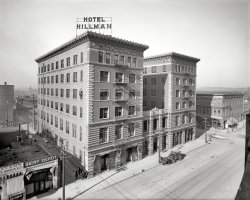
- Bus Baggage: 1943
- ... in Columbus The bus may be Columbus bound but that big hotel in the background is the old Fort Pitt Hotel in Pittsburgh, Pennsylvania.
[Thankyou! - Dave]
It's ... Posted by Dave - 09/17/2014 - 3:06pm -
![Bus Baggage: 1943 September 1943. "Pittsburgh, Pennsylvania. Bringing baggage from a bus." Photo by Esther Bubley for the Office of War Information. View full size.
Not in ColumbusThe bus may be Columbus bound but that big hotel in the background is the old Fort Pitt Hotel in Pittsburgh, Pennsylvania.
[Thankyou! - Dave]
It's very film noirish...in a dark, sort of gloomy way. A bus station in a dark, gritty downtown terminal.
You can almost smell it.
Fort Hayes HotelLooking at the sign on the building behind, that may be the Fort Hayes Hotel which is long gone.
Deja vu...Recently, flying home non-stop from Boston to San Francisco...
It felt exactly like we remember being treated as a Bus Passenger in the 1960's!
Ah, Esther!She's always great.
(The Gallery, Cars, Trucks, Buses, Esther Bubley, Pittsburgh)](https://www.shorpy.com/files/images/SHORPY-8d33007a.thumbnail.jpg)
- Hotel St. Charles: 1910
- Atlantic City, New Jersey, circa 1910. "Hotel St. Charles." It's getting to be that time of year again -- the season ...
The Boardwalk The boardwalk was put up to keep hotel patrons from tracking sand into the lobbies. The St. Charles Hotel was ... Posted by Dave - 08/08/2012 - 2:50pm -
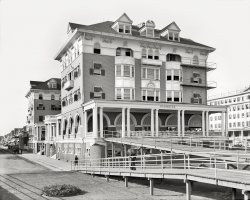
- Hotel Iroquois: 1905
- Buffalo, New York, circa 1905. "Hotel Iroquois." A nice selection of ghost pedestrians in this time exposure. ... Co. View full size.
It's OK But it's no Hotel Netherland.
Awnings The front of the building faced east. If we ... top floors.
Or, facing west If the front of the hotel is indeed facing east then the sun, quite remarkably, is shining from the ... Posted by Dave - 07/22/2012 - 10:40am -
![Hotel Iroquois: 1905 Buffalo, New York, circa 1905. "Hotel Iroquois." A nice selection of ghost pedestrians in this time exposure. Detroit Publishing Co. View full size.
It's OKBut it's no Hotel Netherland.
AwningsThe front of the building faced east. If we could see the rear, it might have had awnings as well. It would have faced the setting sun over Lake Erie and would have provided fairly harsh light in both summer and winter.
[Actually, the front faces west-northwest. - Dave]
Awnings and streetlampsBuildings like this with dozens of awnings fascinate me. Anyone know which direction this building faced? I'd imagine that would make a difference in why one only one side of the building has the awnings at various stages of deployment.
Gorgeous streetlamps as well, and I love all the men in similar boater hats.
What's Hangin'Can anybody identify what the object is that looks like it's hanging from the power lines in the upper right corner of the photo?
[It's lighting for a sign. - Dave]
Fancy!Look at that amazing ironwork at the front door.
Very Stephen King-ishLooks like The Shining meets Rosemary's Baby. Creepy ... especially those top floors.
Or, facing westIf the front of the hotel is indeed facing east then the sun, quite remarkably, is shining from the northeast. Check the shadows of the awnings and the people on the street. Last time I checked Buffalo was in the Northern hemisphere.
West Eagle doesn't quite run straight east-west, but it's pretty close. And it's not early morning here. The sun's quite high. All of which surely suggests that this is in fact early afternoon, and the hotel faces west, not east. Which would explain why there are no awnings on the left of the building. That's the north side.
Top thisThese mansard-roof skyscrapers of the late 1800s were an interesting response to the architects' dilemma of what a tall building should look like, given that there was very little in the way of precedent. Fortunately guys like Burnham and Sullivan came along and put an end to these nightmares. Not many of these mansard-roof jobs are still around these days.
All Aboard!There's lots of ghosting in this photo, but the one that fascinates me is the train/streetcar crossing the back intersection -- it's AWESOME! I can imagine it still moving through the city, invisible to all but ghosts and certain "sensitive" types. It's like seeing traces of a parallel dimension. If it were a Twilight Zone episode, we'd see people boarding it and a conductor taking tickets.
Wouldn't it be niceif your activities of today left some kind of ghostly trace somewhere? The crisp corners of the brickwork seem as though they may have little tolerance for biological membranous activity ...
Interesting HistoryA pretty good one can be found here.
(The Gallery, Buffalo NY, Cars, Trucks, Buses, DPC, Streetcars)](https://www.shorpy.com/files/images/4a12815a.thumbnail.jpg)
- Herald Square: 1908
- ... Sixth Avenue elevated tracks, New York Times building and Hotel Astor. Detroit Publishing Co. View full size.
James Gordon ... be seen far down the tracks on the right.
Hotel Normandie "Absolutely Fireproof"
Made of 100% Asbestos.
Wow! ... Posted by Dave - 12/02/2020 - 2:40pm -
![Herald Square: 1908 New York circa 1908. "Herald Square." Panorama composed of two 8x10 inch glass negatives, digitally merged, showing Broadway at 34th Street. Landmarks include the the New York Herald newspaper building (with its clockwork blacksmith bell-ringers and electrified owls), Sixth Avenue elevated tracks, New York Times building and Hotel Astor. Detroit Publishing Co. View full size.
James Gordon Bennett MonumentThe New York Herald Building was built in 1893 and demolished in 1921. The statue of Minerva, the clock and two owls were saved and are now part of a monument to James Gordon Bennett.
The Mighty HippodromeThe largest theatre in the world at the time, the Hippodrome, can be seen far down the tracks on the right.
Hotel Normandie"Absolutely Fireproof"
Made of 100% Asbestos.
Wow!Just WOW!
An amazing photoThe details are unbelievable. Hours can be spent just studying this photo and I likely will.
"Electrified" owlsSo what did Herald's "electrified" owls do? Light up or move? And what is the tall skinny building just left of the Hotel Astor?
[The owls' eyes lit up at night. The skinny building is the New York Times. - Dave]
Can you find?A head without a hat. I couldn't.
Too much... This one is giving me data overload! So much to see in the image!
It must be a warm Spring or Summer day because I see a lot of men sporting skimmers (flat topped straw hats) and the women are wearing blouses with shorter sleeves and fancy hats.
Toward the lower left of the photo we see a cab (horse drawn type) with the driver, in his top hat, waiting patiently. I suspect that I can see a slight smile on his face. Perhaps there is a pretty girl in his field of view.
Then, there are the two members of the constabulary conversing together, in the lower center of the picture. maybe they are talking about going over to the Lunch wagon on the far right to grab a bite to eat.
What, I ask, is the "House of Hits"? That phrase seems to me to right out of the early '60s Motown, not 1910 New York.
Then there is the Hotel Normandie - Absolutely Fireproof!
It seems that Otard Brandy is still available, even today!
I find it a bit hard to believe, but there seems to be a casino in Midtown Manhattan.
I can't forget Lucio's Pearls. They defy detection! and right above them we have "Paul Jones Pure Rye - Remember the bottle!"
There is so much more to take in, in this photograph.
[In answer to your questions: Jos. W. Stern ("The House of Hits") was a music publisher. The Casino was a theater at 39th and Broadway. - Dave]
80 minutes apartThe glass plates making up the panorama, exposed at 12:04 and 1:24 p.m. Click to enlarge.
Still Where The Action Is!I So LOVE this photo! I would give almost anything to be able to go back to this very spot for a few days to shop, sightsee and experience life during this time. The buildings are lovely, the clothing elegant, the cabs very dapper. I will be studying this one for a long while. Thank you Dave posting this one and for such a wonderful merger of pics.
Herald SquareThat answered my question about why the two clocks had different times.
[There's only one clock here. The dial on the right is a wind rose. - Dave]
FoxyThat Fox Real Estate branding would stand the test of time by today's standards, what a classic. Although the fox better watch out for that self-stropping razor up above.
DaredevilWho are those people on the elevated tracks in the distance? And what are they doing? One looks like a kid on a bicycle, dropping something on the people below.
[That's a man standing with his hand on the railing. - Dave]
Jaywalkers everywhereI have no idea how I could safely drive that street without flattening a well dressed pedestrian or two. The most I can see vaguely in the way of traffic safety is a sign on a lamppost warning about slow moving vehicles. Not even a bollard in sight.
Streetcars or cable carsAre those streetcars or cable cars? The center slot between the rails could hold either the electrical source for streetcars (the "conduit" type) or the moving cable for cable cars. I don't seem to see any trolleys on the cars or overhead trolley wires.
[New York's streetcars drew their power from an underground electrical supply. - Dave]
All those peopleDidn't anyone work? This must be the ultimate Shorpy photo, almost too much to fathom. The city of Vancouver, B.C., had a population of 70,000 in 1907; today the greater Vancouver area is 2.25 million, which most Canadians think of as an unlivable population.
Credit where credit is due.Don Y's post was just fabulous. Thank you Dave and thank you Don Y !!!!
Herald Square ParkNice 2007 article in the New York Times about the statue of Minerva and her bell ringers, "Stuff" and "Guff" (or "Gog" and Magog"), seen here atop the Herald Building. The Herald Building was demolished in 1923, the statue stored, and then in 1939-40 permanently installed back in Herald Square Park.
Present day Herald Square Park as well as the adjacent Greeley Square Park are gores--that is, triangular. Several New York City parks are gores.
But, in front of the Herald Building, is the statue that of Horace Greeley, publisher of the rival Tribune?
The horseless hansomThere is a very interesting cab (?) with a driver up behind in the middle right. Can anyone ID it?
[It's an electric hansom cab. - Dave]
Hussy!The forearms of the young woman in the lower left are entirely exposed. What was the world coming to?
No point in directing the traffic,may as well stand in the middle of the road and have a chat instead. An amazing photo with superb detail. Excellent piece of stitching.
Macy'sLet's not forget Macy's Department store right there on the corner. I used to walk through that very spot almost everyday, and to be honest, it hasn't really changed all that much.
Right Hand DriveAnyone know when American autos converted to left hand drive.
[The transition was a gradual one, with right- and left-hand-drive autos sharing the roads for many years. - Dave]
We may never knowWhat is so fascinating about the carriage with the umbrella? The driver of the Packard, the second wagon and the nearby pedestrians all appear to engrossed. I have visions of a patent medicine barker making an unscheduled pitch, or perhaps a local celebrity on his or her way from the Hippodrome. That Packard, BTW, is one gorgeous automobile.
The menace of lunch wagonsIn the center right sits "Lunch Wagon No.9" - precursor to today's bustling midtown street food scene. Wish I knew what was on the menu.
Here is a 1907 letter to the New York Times complaining about this very lunch wagon for being obstructive. A letter the day before in the Times complained about a food wagon at Union Square that had wheels but hadn't moved in years. This one looks like it could be the same deal.
A couple of years later, there were Suffragette Food Wagons that offered a free side of feminism along with "Suffragette Sandwiches" - shades of Govinda's, a Hare Krishna food cart that has recently disappeared.
WatchYour Step!There is an open access panel in the roadway right where the tracks cross. Interestingly enough, it does not seem to be visible in the left hand of two images, but is quite clear in the right hand one and in the composite photo.
There is one hatless headand it is in a very prominent position in the square. It belongs to the fine statue of William Dodge (now in Bryant Park) in front of the Herald.
Outstanding photograph and merge!
Nobody remembers Rogers Peet anymoreOf course, few people remembered them when they were still open. I got one of my first suits on sale there, but I think that store was uptown from here on 42d Street. It was full of what seemed to be very old people.
Metropolitan opera houseAlso visible is the original Metropolitan opera house at Bway and 39th...
(The Gallery, DPC, NYC, Railroads, Streetcars)](https://www.shorpy.com/files/images/SHORPY-Herald_Square_Panorama.thumbnail.jpg)
- La Fétra's Hotel: 1901
- Hotel owned by Sarah Doan La Fetra -- temperance worker, suffragist, ... side, looking west from 11th Street, showing La Fétra's Hotel on the corner." 5x7 glass negative, D.C. Street Survey. View full size.
1901 Time Warp Caught on Film The man by the hotel's corner pharmacy is stepping into another dimension.
No more La ... Posted by Dave - 01/22/2021 - 12:05pm -
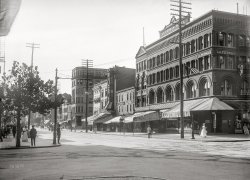
- On Second Thought: 1939
- ... the Farm Security Administration. View full size.
Hotel Yucca The building is now a bank but the swastikas remain around the upper perimeter. More info at Hotel Yucca history .
"An interesting history" ... Posted by Dave - 11/25/2017 - 4:45pm -
![On Second Thought: 1939 September 1939. "Sign along the road near Capulin, New Mexico." Photo by Russell Lee for the Farm Security Administration. View full size.
Hotel YuccaThe building is now a bank but the swastikas remain around the upper perimeter. More info at Hotel Yucca history.
"An interesting history"https://blogs.uh.edu/hotel-historian/2013/03/04/yucca-hotel-new-mexico/
"Freshening the Brand"... as we say in the marketing biz.
"Rest Assured"Rest assured of what? Since it's in quotation marks, I guess it's no guarantee of whatever they have in mind. Kind of like the farmer's market down the road from me with its "Fresh" Vegetables sign.
Native AmericanThe swastika had various innocuous meanings for Southwestern Indian tribes, hence the hotel theme.
Resting assuredI think the "rest assured" means "you are assured to get a good rest here. Safely and comfortably."
[Indeed. It's a pun -- a play on the common idiom "rest assured", the twist being that it's meant literally, in the sense of sleeping or relaxing, as opposed to the figurative sense of "be confident." - Dave]
What They Did Not See ComingThis wasn't an isolated case.
(The Gallery, Russell Lee, WW2)](https://www.shorpy.com/files/images/SHORPY-8b22737u.thumbnail.jpg)
- Lanier Hotel: 1921
- New York, July 5, 1921. "Lanier Hotel restaurant." Fried kidney only 20 cents. Note sleeping mousers. 5x7 glass ... Posted by Dave - 07/09/2013 - 1:40am -
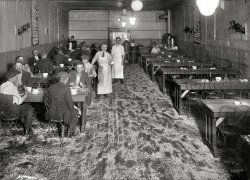
- Hotel Chamberlin: 1905
- ... The Chamberlin, a gigantic Queen Anne-style hotel designed by the firm of Smithmeyer and Pelz, architects of the Library of ... in 1894 and was destroyed by fire in 1920.
1905. "Hotel Chamberlin and government dock, Old Point Comfort, Virginia." 8x10 inch ... Posted by Dave - 09/18/2015 - 12:25pm -
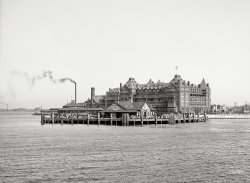
- The Seelbach: 1907
- Louisville, Kentucky, circa 1907. "Seelbach Hotel." Which might have had a roof garden. 8x10 inch glass negative, Detroit ... Seelbach I have childhood memories of this classic old hotel. One of my uncles lived there for many years, and we visited him a number ... Posted by Dave - 08/06/2012 - 1:15am -
![The Seelbach: 1907 Louisville, Kentucky, circa 1907. "Seelbach Hotel." Which might have had a roof garden. 8x10 inch glass negative, Detroit Publishing Company. View full size.
The same view in recent times.The end of "4th Street Live" on Muhammad Ali Boulevard.
Oh yeahThis place is extra swanky. Still going strong (it's a Hilton now).
Vintage steamrollerPowered by steam, as well as providing heat to the roller. I believe they pulled up the cobblestones (maybe working on steam/water/gas lines under the street). Then they "pound sand" and re-lay the cobblestones (in the cart in front of the steamroller).
[No cobbles under this steamroller -- it's on the asphalt part of the street. - Dave]
That's the great advantage of stone pavers, they can be removed, releveled and replaced to smooth out potholes, etc. (They've done this on our paver driveway once, and there's a spot that needs some more sand fill.) Unfortunately, nowadays they pave over these streets, and then the asphalt breaks when the street heaves (from freezing and thawing.) There are some streets near my mother's house that have not been paved over, but it's too labor-intensive to get some guys to pull up the pavers, roll and pound sand, and then replace them.
WindowsThe display windows on the two corner buildings are amazingly large for 1907. Production processes to produce such large single panes were in their infancy and wouldn't be in widespread use until the 1920s.
Roof garden and rathskellerIn addition to a lush vine-covered roof garden, the Seelbach also had a classy Rathskeller in the basement. More postcard views.
That was the way they rolledNow that is an authentic steam-powered steamroller. Also I liked the blurred rush to board the streetcar.
Vintage SeelbachI have childhood memories of this classic old hotel. One of my uncles lived there for many years, and we visited him a number of times. This was a stopping place for presidents, foreign dignitaries, and gangsters in its history.
Somewhere in one of our closets, I have a wooden clothes hanger, engraved with the hotel's name and address.
If power lines cause CancerThen these people would all be dead by now.
There they are againall those guys with bowler hats just hangin' around.
Bring Back HatsSomething was lost when men stopped wearing them.
I'll take a pairJust spent the day with a designer looking for the "perfect" wicker or rattan chair for our production of "Cat on a Hot Tin Roof," and there it is in the window on the right.
A confusing mazeof track and cobblestone!
Seelbach WindowsPlenty of Keystones but no awnings.
High timesStayed at the Seelbach, very nice. Has a nice piano bar and love the old staircases.
Fireproof Hotel
Fireproof Magazine, 1904.
The Seelbach Fireproof Hotel, Louisville.
The Seelbach, which forms the subject of our frontispiece, is one of the latest additions to the fireproof buildings of Louisville, which are increasing in numbers as their value is beginning to be appreciated in beautiful city the Ohio.
It is 136 feet long on Fourth street and 103 feet on Walnut street, and ten stories high, including the roof garden. The first floor is planned with a lobby in the center of the building approached through two entrances. Between the two entrances is a ladies' reception room. On the Walnut street corner is a large cafe 40x90 feet. On the left of the lobby is a men's cafe 40 feet square, with a bar immediately behind.
There will be 200 bed rooms in the hotel and 112 bath rooms. In general there is a bath room between every two bed rooms, although many of the principal bed rooms have private baths.
About half of the area of the tenth floor will be used for a roof garden, which is expected to be a very popular resort in the summer. The floor is paved with large red tiles, the top covered with rolling awnings and the parapet wall decorated with growing plants, lines of electric lights, etc. The roof garden will have its own kitchen, where meats can be cooked on a range in view of the patrons. The remainder of the tenth story will be devoted to a large hall in which both the passenger elevators will land, storerooms for the hotel, carpenter shop, work rooms, etc.
In the basement will be located the general toilet room, barber shop and billiard room. Most of the area of the basement will be occupied by the kitchen, in which no expense is spared to make it as complete and finely equipped as any hotel in the country. Beneath the basement is a sub-basement used for storage, fan rooms, etc.
The interior construction of this hotel will be as thoroughly fireproof as the hollow tile system can make it. All the columns and girders are protected. The floor construction adopted is the Johnson long span system, floors being built in straight slabs from girder to girder. Mr. Andrews had originally contemplated using reinforced concrete floors, but when bids were received it was found that the Johnson tile system was less expensive. The same steel construction was used as would have been the case with concrete. All the partitions are also of hollow tile.
All the woodwork throughout the upper floors will be mahogany. The bath rooms are wainscoted in marble with marble floors and solid porcelain bath tubs keyed into the wall.
The exterior of the hotel is designed in the French Renaissance style. The first two stories and the ninth story are of gray stone. The trimmings at the corners and around the windows are also of gray stone. The wall spaces between the third and ninth stories are faced with the Harvard brick, which is a rich-colored, rough-looking brick of a deep red color, laid in wide, deeply sunk white mortar joints.
The associated architects from whose design and under whose direction the building is erected are Frank M. Andrews of Dayton, Ohio and W.J. Dodd of Louisville. The contractor for the whole is Herman Probst of New York, formerly of Chicago.
(The Gallery, DPC, Louisville, Streetcars)](https://www.shorpy.com/files/images/4a22255a.thumbnail.jpg)
- Honeymoon Hotel: 1941
- ... "Boardinghouse in Baraga, Michigan," a.k.a. the Honeymoon Hotel. View full size. Medium format safety negative by John Vachon for the ... a photo from my home area. This is the old Honeymoon Hotel in Baraga, Michigan, on the Keweenaw Bay Indian Reservation in the Upper ... Posted by Dave - 06/28/2008 - 11:11am -
![Honeymoon Hotel: 1941 August 1941. "Boardinghouse in Baraga, Michigan," a.k.a. the Honeymoon Hotel. View full size. Medium format safety negative by John Vachon for the FSA. This was scanned from an uncaptioned and somewhat misfiled print of the negative. Thanks to Anonymous Tipster for pointing us in the right direction (north).
Wait, Toto, we are in KansasI would guess this was in Kansas. Not many, if any, of these Second Empire style houses in Oklahoma. Kansas had the earlier settlements that would have built in this style, when Oklahoma was Indian Territory.
[This call number for this photo puts it in a batch of pictures taken in Cimarron County, Oklahoma, in April 1936. - Dave]
No, no Toto, we are in Michigan!Yay, finally a photo from my home area. This is the old Honeymoon Hotel in Baraga, Michigan, on the Keweenaw Bay Indian Reservation in the Upper Peninsula. This view looks east toward downtown Baraga and across the bay of Keweenaw with the town of L'Anse on the far side. For another view of this once stately building, see:
http://www.highway41north.com/baraga.html
Scroll down to 1940's, pictures #3 and #4. Thanks to Shorpy for this photo even though not as intended but perhaps it will open to its viewers an area that is rich in Indian, fur trade, lumbering, mining history and say, saloons, houses of ill-repute, safehavens for 1930's Chicago gangsters, and yes, I work in a building just a stone's throw from where this photo was taken....
[Oklahoma, Kansas ... Michigan. And it's by John Vachon, not Arthur Rothstein. From 1941, not 1936. So I was pretty close! Caption updated. Thanks. - Dave]
Not another view - same photoVery interesting - the picture #3 that you reference isn't just another view of the same building - as far as I can tell it's the exact same photo. Makes one wonder about the path they've both taken to make it onto the web. Presumably the picture#3 image is scanned from a print...
[Pics #2 thru #5 on Highway41north.com are all from the LOC archive and were taken by John Vachon. #3 is a low-res scan of a negative; our photo was scanned from a print. - Dave]
Some honeymoon!Lovely accommodations for Mr. and Mrs. Bates.
While in the neighborhood....The buildings noted in Highway41north.com, #2, #3/#4 are long gone but St. Anne's Catholic Church in #5 looks pretty much the same however it has an addition towards the rear and some needed landscaping around the steps....
Looks Like a Hopper PaintingThat sky is spooky. Not a soul in sight. Amazing photo.
Cool! My jaw dropped when I saw the pic and caption! I grew up in this area, and it's always fun to stumble upon these things on the web!! Thanks for posting, and thanks to the previous poster for the website with all the other pictures! I am a sucker for history and historical buildings and how things were back then.... This is a very haunting building... I love the ambience of it.
Very cool!
Forty years earlier...The hotel 40 years earlier.
(The Gallery, John Vachon, Rural America)](https://www.shorpy.com/files/images/8c36807u.thumbnail.jpg)
- New Hampshire Hotel: 1905
- ... not. Two-fifths of that bank is gone, and the entire hotel. It’s been gone a while because the replacement buildings are quite old too!
[The hotel is indeed gone, except for its grin. - Dave]
When Did It Burn Down? ... Posted by Dave - 02/13/2018 - 10:45pm -
![New Hampshire Hotel: 1905 Keene, New Hampshire, circa 1905. "Cheshire House." 8x10 inch dry plate glass negative, Detroit Photographic Company. View full size.
I've always wondered.Was there a specific reason that periods were used on signage of this era? Or was it just a peculiarity that sign painters always did and never questioned?
Lost Opportunities #3764Time was when a person could earn a pretty good living making awnings.
Aerial spoolJust to the right of the Cheshire House(.), directly in front of "The Kitchen(.)" there is what looks like a metal spool fastened to a pole, which is in turn fastened to a stone post. Can anyone identify this contraption?
[Appears to represent an apothecary's mortar and pestle to advertise the adjoining drug store. -tterrace]
I see it now. A brilliant deduction on the part of tterrace!
I recognized none of this!This was so unrecognizable I thought perhaps Keene was mislabeled -- but it’s not. Two-fifths of that bank is gone, and the entire hotel. It’s been gone a while because the replacement buildings are quite old too!
[The hotel is indeed gone, except for its grin. - Dave]
When Did It Burn Down?An inside joke for long-time Shorpy members. Happy Birthday, Shorpy!
(The Gallery, DPC, Stores & Markets)](https://www.shorpy.com/files/images/SHORPY-4a12287a.thumbnail.jpg)
- Hotel Gus: 1905
- ... circa 1905. "Resort sightseers on dock of Gus. Trautz's Hotel." 8x10 glass negative, Detroit Publishing Company. View full size.
... building is still there... Built in the 1870's, this hotel was bought by Gus Trautz in 1898. It was known by many names: Kehl's ... Posted by Dave - 09/12/2012 - 10:38am -
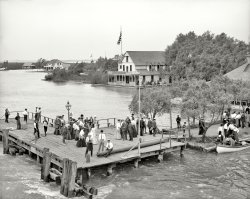
- Hotel Pullman: 1900
- Hot Springs, Arkansas, circa 1900. "The Hotel Pullman." HELP WANTED: Sidewalk jockey with a good head on his ... Co. View full size.
Pullman? So did the hotel's beds fold down out of the ceiling?
Not shown: "Bathhouse ... shoe shine stands in railroad stations, airports, and hotel lobbies. The 'shoeshine boy' (just a name since many were adults) usually ... Posted by Dave - 05/17/2014 - 11:42pm -
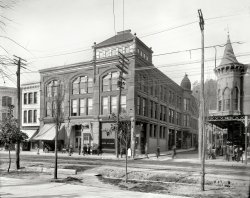
- Grand Hotel: 1908
- ... City, New Jersey, circa 1908. "Marlborough-Blenheim Hotel." All this needs is some icing and a bride and groom on top. View full ... on the Boardwalk ?
No, No, Nanette! This fabulous hotel had famously fabulous afternoon teas. Irving Caesar wrote the words to ... Posted by Dave - 08/03/2012 - 4:07pm -
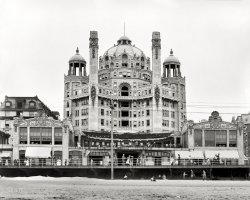
- Hotel Seminole: 1910
- Jacksonville, Florida, circa 1910. "Hotel Seminole." 8x10 inch dry plate glass negative, Detroit Publishing ... know it at the time, but the opening of the Seminole Hotel in 1910 was the beginning of the end for that.
Miami, 300+ miles to ... dining and lounging (or drinking) - yet this is the first hotel I have seen that does that! Now I'll have to look out for more.
... Posted by Dave - 07/31/2012 - 4:16pm -
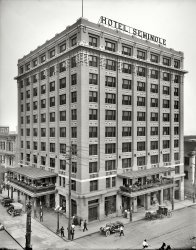
- Gulf Hotel: 1939
- The Gulf Hotel building (and lighthouse) at 1315 Fifth Street.
April 1939. "Even ... Thank you for all of the wonderful pictures of this hotel/ gas station.
Amazing that they would have to advertise for a ... Posted by Dave - 04/26/2019 - 11:58am -
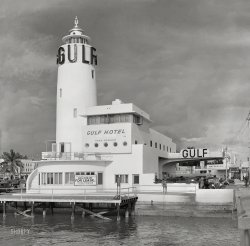
- Hotel Windle: 1910
- ... only ones I can identify with any certainty are the large (hotel?) in the center of the photo and the smaller, more classical structure ... lot quainter than the current City Hall And you can see Hotel Windle behind it.
http://www.floridamemory.com/items/show/166965
... Posted by Dave - 08/21/2012 - 8:34pm -
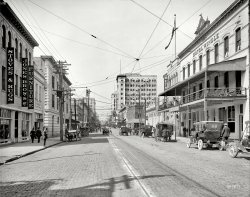
- The Claypool: 1904
- Indianapolis, Indiana, circa 1904. "Claypool Hotel, Washington and Illinois Streets." And, at far left, THE PENCE. We wonder ... Company. View full size.
Indy's Grandest Hotel Further reading on the Claypool: A Look at Indy's Grandest Hotel ... Posted by Dave - 07/15/2018 - 5:02pm -
